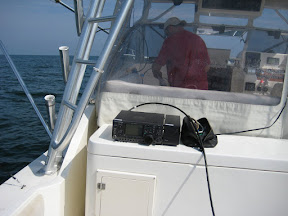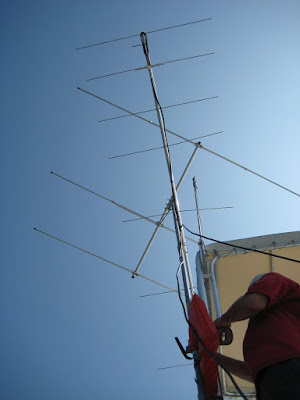This is part 3 of a series. Here are the links to Part I and Part II.
 Now that the antennas were set up (or so we thought), the next task was to connect the radios. I'd be using an Icom 746 Pro outside on the stern of the boat for 6m, while Matthew would be using the Icom 910 for 2m inside the cockpit. (Yes, I did get a little bit of sunburn, but it was the most sun I'd had all summer, so I wasn't complaining.) Now for a bit of explanation (as promised earlier) about what "Limited Multi-Op" means.
Now that the antennas were set up (or so we thought), the next task was to connect the radios. I'd be using an Icom 746 Pro outside on the stern of the boat for 6m, while Matthew would be using the Icom 910 for 2m inside the cockpit. (Yes, I did get a little bit of sunburn, but it was the most sun I'd had all summer, so I wasn't complaining.) Now for a bit of explanation (as promised earlier) about what "Limited Multi-Op" means.
For most contests, there are one or more categories used to describe your entry. For instance, you might be a single operator at a station (which is how I do most of my contesting), you might participate with a group of operators; you might run high power with amplifiers, regular power, or low power (called "QRP"); and you might operate just a single band or a single mode. For the VHF contests, there's something called "Limited Multi-Op", which means that you can have more than a single operator, but you are limited to submitting contacts on at most four different bands. This is important in these types of contest in order to allow more stations to be competitive. For VHF contests, there are many more bands available than in HF contests because of the way that the radio spectrum is allocated. (For HF contests, there are five or six bands that can be used; For VHF contests, it can be up to sixteen.) As it turns out, we wound up operating on just two bands (6m and 2m) because it was just too difficult to use additional antennas.
Finally, the antennas were mounted, the radios connected, the generator running (the  Maryleen has a built-in generator that starts with a push of a button; it was very convenient), it was already past the start time of the contest ... time to get on the air. We decided that we'd initially just point the antennas due west to work the folks in central New Jersey and Pennsylvania who nearby, then later swing up towards New England and down towards Maryland, Virginia, and farther south. Captain Karl was up on the upper bridge and used the "armstrong" method to turn the antenna to face the south, and Matthew and I started CQing. After a contact or two I looked up to double-check the direction of the antenna and discovered that they were no longer pointing in the same direction. What had happened was that the gentle rocking of the boat was just enough to cause the two mast sections to rotate around each other, resulting in the two antennas no longer pointing in the same direction. The mast sections were just nested into one another, and I'd (wrongly) assumed that the friction caused by the weight of the antenna pressing down would be sufficient to keep it from rotating freely, while still allowing us to turn the antennas as needed when we wanted to. Along with Captain Karl's help, we were able get the two upper mast sections to lock tightly enough so that they acted as a single section, and we were back in business. Of course, turning the mast by hand was now very difficult, so Captain Karl used a gaff to get enough leverage against antenna so that we could turn it.
Maryleen has a built-in generator that starts with a push of a button; it was very convenient), it was already past the start time of the contest ... time to get on the air. We decided that we'd initially just point the antennas due west to work the folks in central New Jersey and Pennsylvania who nearby, then later swing up towards New England and down towards Maryland, Virginia, and farther south. Captain Karl was up on the upper bridge and used the "armstrong" method to turn the antenna to face the south, and Matthew and I started CQing. After a contact or two I looked up to double-check the direction of the antenna and discovered that they were no longer pointing in the same direction. What had happened was that the gentle rocking of the boat was just enough to cause the two mast sections to rotate around each other, resulting in the two antennas no longer pointing in the same direction. The mast sections were just nested into one another, and I'd (wrongly) assumed that the friction caused by the weight of the antenna pressing down would be sufficient to keep it from rotating freely, while still allowing us to turn the antennas as needed when we wanted to. Along with Captain Karl's help, we were able get the two upper mast sections to lock tightly enough so that they acted as a single section, and we were back in business. Of course, turning the mast by hand was now very difficult, so Captain Karl used a gaff to get enough leverage against antenna so that we could turn it.
From that point on, it was smooth sailing (sorry, couldn't resist the pun) at least for me. Although the  actual contacts were coming a bit more slowly than I'd hoped, I was having an awful lot of fun. Probably the best part of all of this was when a station, upon hearing that we were in FM39, would respond with "You're where???". Once confirmed that we were, indeed, in that rare all-water grid, you could hear the smile on folks faces. Aside from being a new grid for most people for the VUCC award, we were reasonably sure that we were the only station operating from FM39, which meant that we counted as a unique multiplier for contest purposes. Although I never was able to generate much of a pileup, giving out a rare grid was just a tremendous amount of fun. (And in case you're wondering: Yes, I know there's a microphone on the headset that's sitting on my head. I was using the hand mic because I hadn't brought my footswitch and it was just plain easier to use the hand mic.)
actual contacts were coming a bit more slowly than I'd hoped, I was having an awful lot of fun. Probably the best part of all of this was when a station, upon hearing that we were in FM39, would respond with "You're where???". Once confirmed that we were, indeed, in that rare all-water grid, you could hear the smile on folks faces. Aside from being a new grid for most people for the VUCC award, we were reasonably sure that we were the only station operating from FM39, which meant that we counted as a unique multiplier for contest purposes. Although I never was able to generate much of a pileup, giving out a rare grid was just a tremendous amount of fun. (And in case you're wondering: Yes, I know there's a microphone on the headset that's sitting on my head. I was using the hand mic because I hadn't brought my footswitch and it was just plain easier to use the hand mic.)
A bit of explanation is in order for my "at least for me" comment above.  Unfortunately, Matthew and relatively small boats don't seem to get along too well. Although Matthew is a big fan of cruise ships (of the several hundred foot long variety), he's very prone to "mal de mer" on smaller boats, even when the seas were quite calm, as they were for us. He was fine on the trip down to FM39, fine while setting up the antennas, but just as we started setting up the radios, he starting feeling a little dizzy, and had to sit down for a bit. Fortunately, the call of the airwaves was good medicine, and Matthew was able to recover to get on the air, though he did have to take a few breaks now and then. As it turns out, because the 2m beam significantly outperformed the 6m beam, Matthew wound up making more contacts on 2m than I did on 6m, despite the breaks.
Unfortunately, Matthew and relatively small boats don't seem to get along too well. Although Matthew is a big fan of cruise ships (of the several hundred foot long variety), he's very prone to "mal de mer" on smaller boats, even when the seas were quite calm, as they were for us. He was fine on the trip down to FM39, fine while setting up the antennas, but just as we started setting up the radios, he starting feeling a little dizzy, and had to sit down for a bit. Fortunately, the call of the airwaves was good medicine, and Matthew was able to recover to get on the air, though he did have to take a few breaks now and then. As it turns out, because the 2m beam significantly outperformed the 6m beam, Matthew wound up making more contacts on 2m than I did on 6m, despite the breaks.
To be continued...
No comments:
Post a Comment